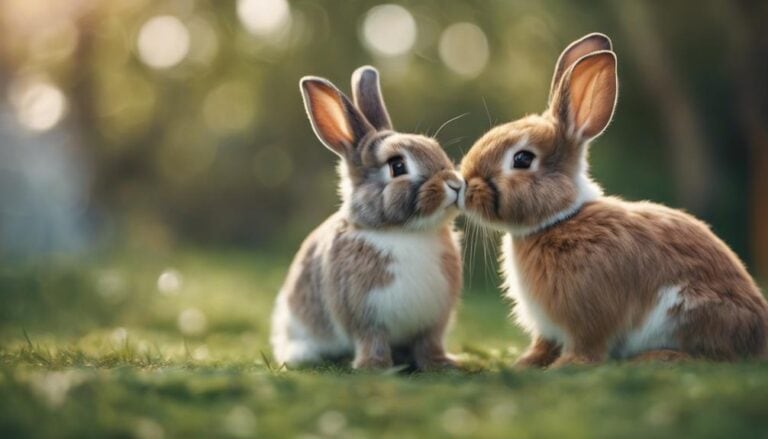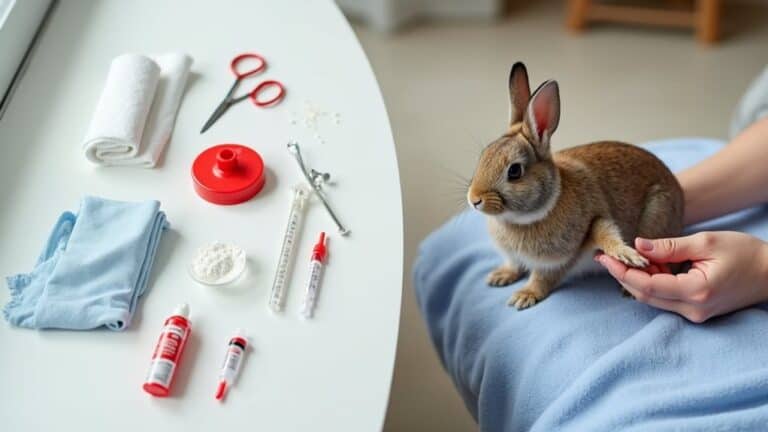Ever wondered how bunnies pee? Well, it’s pretty simple. Their kidneys work to filter waste from their blood. This waste then travels through small tubes called ureters to the bladder, where it’s stored until it’s ready to be expelled through the urethra. Bunny urine usually has a yellow color, but sometimes it can be white due to high calcium levels. Changes in urine color can actually tell you a lot about your bunny’s health.
Bunnies use their pee to mark their territory, which is a pretty common behavior among many animals. By keeping an eye on your bunny’s peeing habits, you can get a better understanding of their unique behaviors. If you notice any unusual changes in their urine, like a dark color or a strong odor, it could be a sign of health issues like dehydration or infections.
To help maintain your bunny’s urinary health, it’s important to pay attention to their diet. Make sure they have access to fresh water at all times and feed them a balanced diet. If you ever have concerns about your bunny’s urine or overall health, don’t hesitate to consult with a veterinarian. Taking good care of your furry friend’s urinary health can help keep them happy and thriving.
Contents
Key Takeaways
Bunnies pee through their urethra, just like humans do. They use their urine to mark their territory and communicate with other bunnies. So if you see your bunny peeing in different spots, it’s their way of saying, “This is mine!”
The color of a bunny’s pee can tell you a lot about their health. Generally, it should be a pale to medium yellow color. If you notice any drastic changes in color, like dark yellow or red, it could be a sign of a health issue and you should consult a vet.
Peeing habits can also tell you if your bunny is hydrated and healthy. Bunnies should be peeing regularly throughout the day. If you notice a sudden decrease or increase in their pee frequency, it could be a sign of a health problem that needs attention.
Remember, paying attention to your bunny’s pee habits and the color of their urine can help you keep an eye on their health and catch any potential issues early on.
Anatomy of Bunny Urinary System
[SUBHEADING IMAGE SLOT 0]
Have you ever wondered how a bunny’s pee system works? Well, bunnies have a pretty important pee system that includes the kidneys, ureters, bladder, and urethra. These parts all work together to help the bunny get rid of waste.
So, the kidneys do the heavy lifting by filtering waste from the blood and making pee. This pee then travels through the ureters to the bladder, which is like a storage tank for pee. The bladder holds onto the pee until it’s time for the bunny to let it all out through the urethra when they pee.
The kidneys are like the body’s own cleanup crew, making sure the right balance of liquids and minerals is maintained. They filter out all the junk and extra stuff, turning it into pee. This pee collects in the bladder, a stretchy bag that can hold different amounts of pee before telling the brain it’s time to go.
Knowing how a bunny’s pee system works is super important for spotting any pee problems early on. By understanding how the bladder and kidneys team up in this fancy system, you can take better care of your fluffy buddy and keep them healthy and happy.
Urine Release Process in Bunnies
When a bunny has to pee, its bladder squeezes to push urine out through the urethra. It’s important to know what bunny pee is made of, how they go about peeing, and any health issues that might come up with urination.
Keeping an eye on how often your bunny pees can tell you a lot about how they’re doing.
Bunny Urine Composition
Bunny pee has two types: regular yellow pee and calcium-rich white pee. The white pee has extra calcium that bunnies need to balance their calcium levels. Normally, bunny pee looks clear or a bit yellow.
It’s important to keep an eye on the color and texture of bunny pee because changes can signal health problems. Bunnies get rid of pee through their urinary tract, which is crucial for getting rid of waste and keeping their bodies working properly.
Knowing about bunny pee, especially the calcium in the white pee, can tell you a lot about your bunny’s health and how they’re doing.
Peeing Behavior in Bunnies
Bunnies pee by squatting and letting out their urine on a surface or in a litter box. Their pee has a strong ammonia smell due to its high concentration. They pee a lot to stay hydrated and mark their territory.
Bunnies have a natural tendency to pick specific spots for peeing, which makes litter training quite easy. It’s important to keep an eye on your bunny’s peeing habits as it can tell you a lot about their health and hydration levels. By watching how they pee, you can ensure they’re happy and healthy.
Health Concerns With Urination
Rabbits rely on their urinary system to stay healthy. It helps them stay hydrated and get rid of toxins.
Issues with urination, like dehydration, urinary tract infections, and bladder stones, can affect a bunny’s well-being. Keeping an eye on your bunny’s peeing habits can give you important clues about their health.
If you notice any changes in how often they pee, the color, or smell, it’s best to see a vet right away. Regular check-ups with the vet can help catch any urination problems early on, keeping your bunny happy and healthy.
Frequency of Bunny Urination
Rabbits usually pee several times a day. On average, adult bunnies pee about 6-8 times a day. How often they go can be affected by things like their age, health, what they eat, and how much they drink.
It’s important to keep an eye on how often your bunny pees so you can spot any possible health problems early. If you notice any changes, it’s a good idea to get your bunny checked out by a vet.
Peeing Frequency Patterns
Bunnies pee at different frequencies depending on factors like age, diet, and how hydrated they are. A healthy adult rabbit might pee several times a day. Young and old bunnies could pee more often due to differences in metabolism.
A well-hydrated adult bunny may urinate around 2-8 times daily. It’s important to keep an eye on your rabbit’s pee habits because changes could indicate health issues. By knowing what’s normal for your bunny, you can quickly spot any changes that might need a vet’s attention.
Watching and keeping track of your rabbit’s pee patterns can help you take care of their health and catch any problems early.
Factors Affecting Urination
Factors that can affect how often bunnies pee include how much water they drink, their diet, and any health problems they might have.
When bunnies are well-hydrated, they tend to pee more often compared to when they don’t drink enough water. Foods that have a lot of water in them can also make bunnies pee more frequently. It’s important to keep an eye on your bunny’s urine output to catch any potential issues early on.
Health issues like bladder sludge, stones, or urinary tract infections can also impact how often a bunny pees. So, it’s crucial to monitor your bunny’s bathroom habits to spot any changes that could signal a problem.
Other factors like stress, temperature, and access to water can also play a role in how often bunnies pee. By understanding these factors, you can help keep your bunny’s urinary health in check.
Normal Bunny Urination
Properly keeping an eye on how often your bunny pees is super important for their urinary health. Usually, bunnies go to the bathroom around 2-8 times a day, but this can change depending on things like how old they are, what they eat, and how much water they drink. Healthy rabbits typically have clear, light yellow pee, which shows they’re well-hydrated. But if they drink more water or have certain health issues, they might pee more.
It’s crucial to pay attention to any differences in how often your bunny pees or the color of their pee, as these could be signs of health problems. Also, watch out for any pee dribbling, as that could mean a urinary issue that needs the vet’s help. By regularly checking and noting down your bunny’s peeing habits, you can catch and treat any potential health concerns early on.
Characteristics of Bunny Urine
Keeping an eye on your bunny’s pee is crucial for keeping tabs on your pet rabbit’s health. Here are some things to look out for:
- Bunny pee is usually clear to yellow, but it can vary depending on how much water your rabbit drinks and what they eat.
- If your bunny is feeling dehydrated, their pee might look darker, signaling that they need more water.
- The color of bunny pee can change to red, brown, or even white, depending on factors like diet, hydration, and any health issues they might have.
Monitoring Bunny Urine for Health
[SUBHEADING IMAGE SLOT 10]
Monitoring your bunny’s urine color regularly is crucial for checking their health and catching any issues early. The color of your rabbit’s pee can give important hints about how they’re doing.
If you see dark urine, it could mean they’re dehydrated, so it’s important to act quickly to prevent further problems. Red urine is usually harmless, but you can do a hydrogen peroxide test to be sure.
Orange or brown urine is usually not a big concern, but it might indicate dehydration, so make sure your bunny is getting enough fluids. If you notice white or milky urine, it could mean your bunny is getting too much calcium in their diet.
In that case, it’s a good idea to talk to a vet to make sure your rabbit’s calcium levels are right. By keeping an eye on your rabbit’s pee and noticing any changes early on, you can help keep your bunny healthy and happy.
Common Urinary Issues in Bunnies
When it comes to common urinary issues in bunnies, it’s important to keep a close eye on your pet’s bathroom habits to catch any problems early. Bladder sludge and stones are common issues for bunnies, which can show up as more frequent urination and dribbling pee. These stones can be caused by genetics, not drinking enough water, lack of exercise, or living in an unsuitable environment. To help prevent bladder stones, make sure your bunny drinks plenty of water, avoids alfalfa foods, eats leafy greens, gets enough exercise, and has a clean litter box.
Urinary tract infections (UTIs) are bacterial infections that bunnies can get, and they need to be treated by a vet with specific methods to prevent them from coming back. By keeping a close watch on your bunny’s bathroom habits and getting them to the vet quickly if you notice any changes, you can help prevent and treat these common urinary issues. And don’t forget, a clean litter box isn’t just about keeping things tidy—it’s also crucial for your bunny’s urinary health.
Frequently Asked Questions
Where Does Rabbit Pee?
So, when you’re wondering where rabbit pee goes, here’s the scoop: it gets absorbed by a special system in their bladder. This system lets them soak up water and important nutrients from their pee. It’s like a recycling program in their bodies that helps them stay hydrated and hold onto key resources. Pretty nifty, right?
What Does Bunny Pee Look Like?
When you look at your bunny’s pee, pay attention to its color to get an idea of their health. If it’s yellow, that’s a good sign that everything is okay. But if you see pee that’s reddish or brownish, it might mean there are some issues you need to look into. It’s a good idea to keep an eye on the consistency of their pee regularly to make sure they’re doing well.
Do Rabbits Clean Their Bottoms?
Rabbits keep their bottoms clean by grooming with their tongues and front paws. This helps them stay tidy and avoid any waste buildup. It’s important to watch your rabbit to make sure they are clean and comfortable. If you notice any changes, it could be a sign of health issues that need attention.
Do Rabbits Use Litter Boxes?
Yes, rabbits can be trained to use litter boxes just like cats. Simply put the litter box in a quiet spot where your rabbit feels comfortable. Be sure to clean the box regularly to keep odors in check. It’s a good idea to use absorbent bedding to help with this.
Keep an eye on your rabbit’s habits. Changes in their litter box usage could be a sign of health issues or stress. By staying observant, you can address any concerns early on. With a little patience and consistency, your rabbit can learn to use a litter box effectively.
Conclusion
So there you have it, we’ve uncovered the mysteries of how bunnies pee! Just like a well-oiled machine, a bunny’s urinary system works tirelessly to keep them healthy and happy.
It’s important to keep an eye on your furry friend’s urine to make sure they’re in tip-top shape. Remember, a bunny’s pee can give you valuable insights into their well-being, so it’s essential not to overlook this aspect of their health.
Let’s keep those bunnies hopping and peeing like pros!



